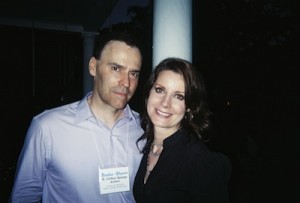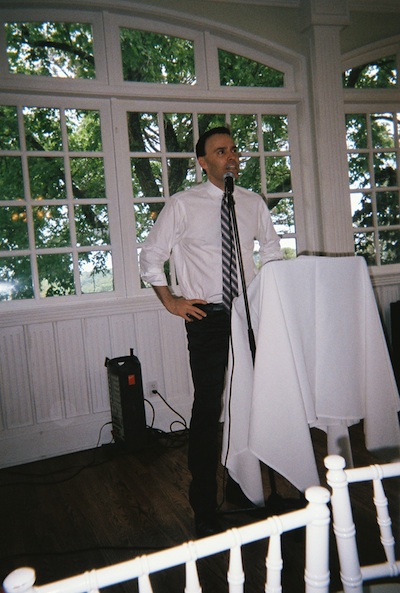Last week I visited Eureka Springs, Arkansas to talk about Zelda and F. Scott Fitzgerald and my new novel Beautiful Fools for the Books in Bloom Literary Festival, my first book tour appearance beyond Iowa City or Chicago. I was one of four featured speakers, sharing the marquee with three New York Times best-selling authors, Catherine Coulter, James Grippando, and Craig Johnson, as well as a list of other notable authors who also spoke at the festival.
The trip was full of unexpected surprises, beginning with the lavish scenery unfurling along the steep, winding roads that led up to the historic mountain town. I drove down from Iowa City using MapQuest directions, which served me well until I hit the old train depot near Eureka Springs – at which point MapQuest suddenly became very confused. The street plan for Eureka Springs involves looping, sometimes maze-like streets (once you figure it out, though, the grid is actually pretty coherent). It’s an old Victorian resort village with over 140 natural springs once believed to have healing powers. The city endured its up and downs in the 20th century, a boom in the 1930s precipitated by an influx of some Chicago expat artists, then a long cooling off, only to be revitalized as an arts community in the early 1970s by hippies, visual artists, and writers in search of calm, quiet, and some experimental forms of natural healing. Now the city is known as much for its colorful and well-preserved distinctive architecture, including spas, luxury hotels, and charming bed and breakfast establishments, as for its still vibrant arts community.
I stayed at The Crescent Hotel and Spa, built in 1886, widely reputed to be haunted — in fact it was voted one of America’s most haunted hotels. Take a look at the resort’s formidable limestone face and you’re quickly imagining visitations from long-forgotten guests or (a la Rebecca) ghostly dead wives. I can’t lay claim to any supernatural encounters, but I did meet an unusual gray cat lounging unapologetically across the landing of the staircase that led up to the second floor of the hotel. Though very much alive, he had about as much regard for the guests taking the stairs as you’d expect from an apparition.
My presentation at Books in Bloom was adapted from a piece I wrote for Glo on taking relationship advice from Scott and Zelda Fitzgerald– good idea or bad? I riffed on a few of the lessons from that piece, expanding here and there, adding a few new ones and reading aloud two relevant passages from Beautiful Fools – The Last Affair of Zelda and Scott Fitzgerald. I concluded with a lesson the Fitzgeralds may have learned from that desperate 1939 trip to Cuba that turned out to be their last. This lost trip is the premise for Beautiful Fools — here’s a shortened version of my closing remarks:
Don’t (or Do) Give Up the Fight. In spring 1939 Scott was living in Hollywood, deeply in debt and writing for the movies, Zelda in a mental health sanitarium in North Carolina, when he suddenly flew east to take her for a week’s vacation in Cuba. It was the last time (though neither of them knew it at the time) they would ever see each other. Though the trip didn’t go according to plan, Scott speculated in subsequent correspondence about bringing Zelda to California some time that summer of 1939, plans which didn’t come to fruition for various reasons, including their daughter Scottie’s appendectomy. For the highs and lows of what may have happened on this last vacation, (one clue: Scott Fitzgerald tries to break up a cockfight, probably not a good idea), you’ll have to read Beautiful Fools. Beautiful Fools. Even when their holidays went off the rails, though, Zelda remained uncowed. “There are lots of happy places,” she wrote him after their Cuban sojourn, “it says so in the time tables, and before long we’ll surely find one.”
My favorite part of any reading is the “Question & Answer” session. Here are two of the questions tossed my way from the crowd at Eureka Springs, followed by what I remember saying.
Q: How do you write a novel about a historical event about which almost nothing is known?
The absence of information about the Fitzgeralds’ trip to Cuba was a blessing in heavy disguise. The reason I say heavy disguise is that you still have to do all the research demanded of good historical fiction. For example, I immersed myself in the many, many biographies on Zelda and Scott, and in their correspondence, especially the letters from late in life (collected in Dear Scott, Dearest Zelda). I logged hours with the Fitzgerald papers in the library at Princeton University. I researched Cuba in 1939, read travel guides, interviewed Cubans, got myself to Cuba during the summer of 2010. All of which was necessary if only to create the frame, to find the form of their holiday and fill it with historically accurate details. Still, there’s a blessing in mostly not knowing what Scott and Zelda did there. It gives license to the imagination. Since the historian can’t know what happened, the novelist must make it up. You work to contrive a series of events and behaviors largely consistent with what we know about the Fitzgeralds from that era in their too famous lives. But since they’re also off the historical grid — no one knows what they planned, where they visited, what they longed for when they found themselves again in each other’s company — I get to invent possibilities, fortunes, misfortunes. In doing so, I get to reinvent the Fitzgeralds, and allow Scott and Zelda one last experiment in reinventing themselves.
Q: Was Fitzgerald’s’s alcoholism as bad as it has been reported, or is that just part of the myth that surrounds him?
Sadly, it was perhaps worse than the world imagines. He always had a problem with drink. He and Zelda were often on the wagon in the early days of their marriage, pulling out of long binges and sobering up because they saw the hazards in their conduct. The question for most Fitzgerald scholars is when did Scott’s alcoholism become debilitating. Also, it’s important to remember the overlay of mental illness (in Scott’s case, depression) with alcoholism, and the relatively limited resources available to treat alcoholism as a disease at the time. People went in for the cure (as Scott did frequently later in life); then they sobered up, and went back to drinking moderately until they fell off the wagon again. The truly debilitating era for Fitzgerald arrived in the 1930s. My own belief is that Zelda’s mental illness (itself reinforced by her own alcohol abuse and Scott’s inability to stop drinking) sent him into that debilitating period later described in “The Crack-Up” and several other essays written for Esquire in 1936. For the most part, though, Scott did not “write drunk” — he needed to sober up to do his best work. He couldn’t hold his liquor but he revered the process of writing enough not to poison it with booze. And the fact is that he was on the wagon for most of his last years in Hollywood, while writing for MGM, while making a terrific start on the book he left unfinished at his death, The Love of the Last Tycoon. That novel might well have proved his best, outstripping Gatsby and even Tender is the Night, if only he’d lived one more year.




